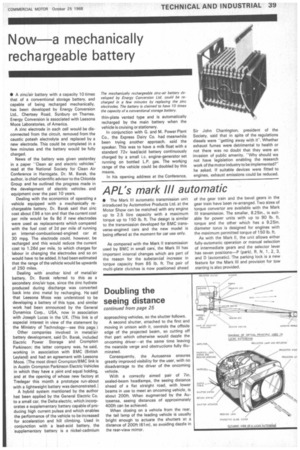Now a mechanically rechargeable battery
Page 41

If you've noticed an error in this article please click here to report it so we can fix it.
• A zinc/air battery with a capacity 10 times that of a conventional storage battery, and capable of being recharged mechanically, has been developed by Energy Conversion Ltd.. Chertsey Road, Sunbury on Thames. Energy Conversion is associated with Leesona Moos Laboratories, of America.
A zinc electrode in each cell would be disconnected from the circuit, removed from the caustic potash electrolyte and replaced by a new electrode. This could be completed in a few minutes and the battery would be fully Charged.
News of the battery was given yesterday in a paper "Clean air and electric vehicles" read at the National Society for Clean Air Conference in Harrogate. Dr. M. Barak, the author, is chief scientific advisor to the Chloride Group and he outlined the progress made in the development of electric vehicles and equipment over the past 10 years.
Dealing with the economics of operating a vehicle equipped with a mechanically rechargeable battery, Dr. Barak said that zinc cost about £96 a ton and that the current cost per mile would be 6s 8d if new electrodes were used as replacements which compared with the fuel cost of 2d per mile of running an internal-combustioned-engined car at 30 mpg. The electrode could, however, be recharged and this would reduce the current cost to 1.26d per mile, to which charges for labour in changing the electrodes and so on would have to be added. It had been estimated that the range of the vehicle would be upwards of 250 miles.
Dealing with another kind of metal/air battery. Dr. Barak referred to this as a secondary zinc/air type, since the zinc hydrate produced during discharge was converted back into zinc metal by recharging. He said that Leesona Moos was understood to be developing a battery of this type, and similar work had been announced by the General Dynamics Corp., USA, now in association with Joseph Lucas in the UK. (This link is of especial interest in view of the statement by the Ministry of Technology—see this page.) Other companies involved in metal/air battery development, said Dr. Barak, included Electric Power Storage and Crompton Parkinson; the latter company was, he said, working in association with BMC (British Leyland) and had an agreement with Leesona Moos. I The most direct Crompton/BMC link is in Austin Crompton Parkinson Electric Vehicles in which they have a joint and equal holding, and at the opening of whose new factory at Tredegar this month a prototype run-about with a lightweight battery was demonstrated.1 A hybrid system mentioned by the author has been applied by the General Electric Co. to a small car. the Delta electric, which incorporates a supplementary battery capable of producing high current pulses and which enables the performance of the vehicle to be increased for acceleration and hill climbing. Used in conjunction with a lead-acid battery, the supplementary battery is a nickel-cadmium
The mechanically rechargeable zinc-air battery de veloped by Energy Conversion Ltd. could be recharged in a few minutes by replacing the zinc electrodes. The battery is claimed to have 10 times the capacity of a conventional storage battery.
thin-plate vented type and is automatically recharged by the main battery when the vehicle is cruising or stationary.
In conjunction with G. and M. Power Plant Co., the Express Dairy Co. had meanwhile been trying another approach, said the speaker. This was to have a milk float with a standard 72v lead/acid battery continuously charged by a small i.c, engine-generator set running on bottled L.P. gas. The working range of the vehicle could be doubled by this means.
In his opening address at the Conference.
Sir John Charrington, president of the Society, said that in spite of the regulations diesels were "getting away with it-. Whether exhaust fumes were detrimental to health or not there was no doubt that they were an invasion of public amenity. "Why should we not have legislation enabling the research work of the motor industry to be implemented?" he asked. If suitable devices were fitted to engines, exhaust emissions could be reduced.
















































































































